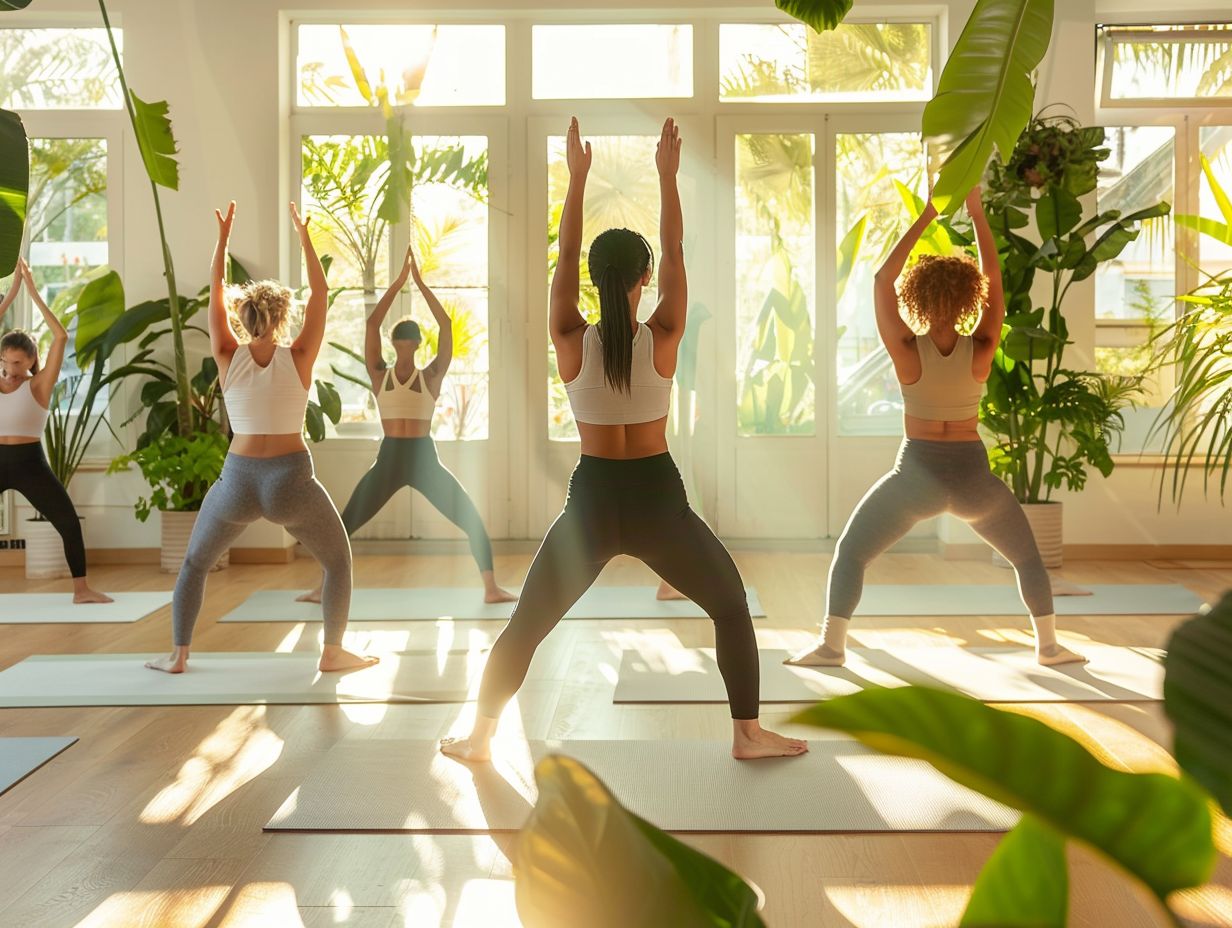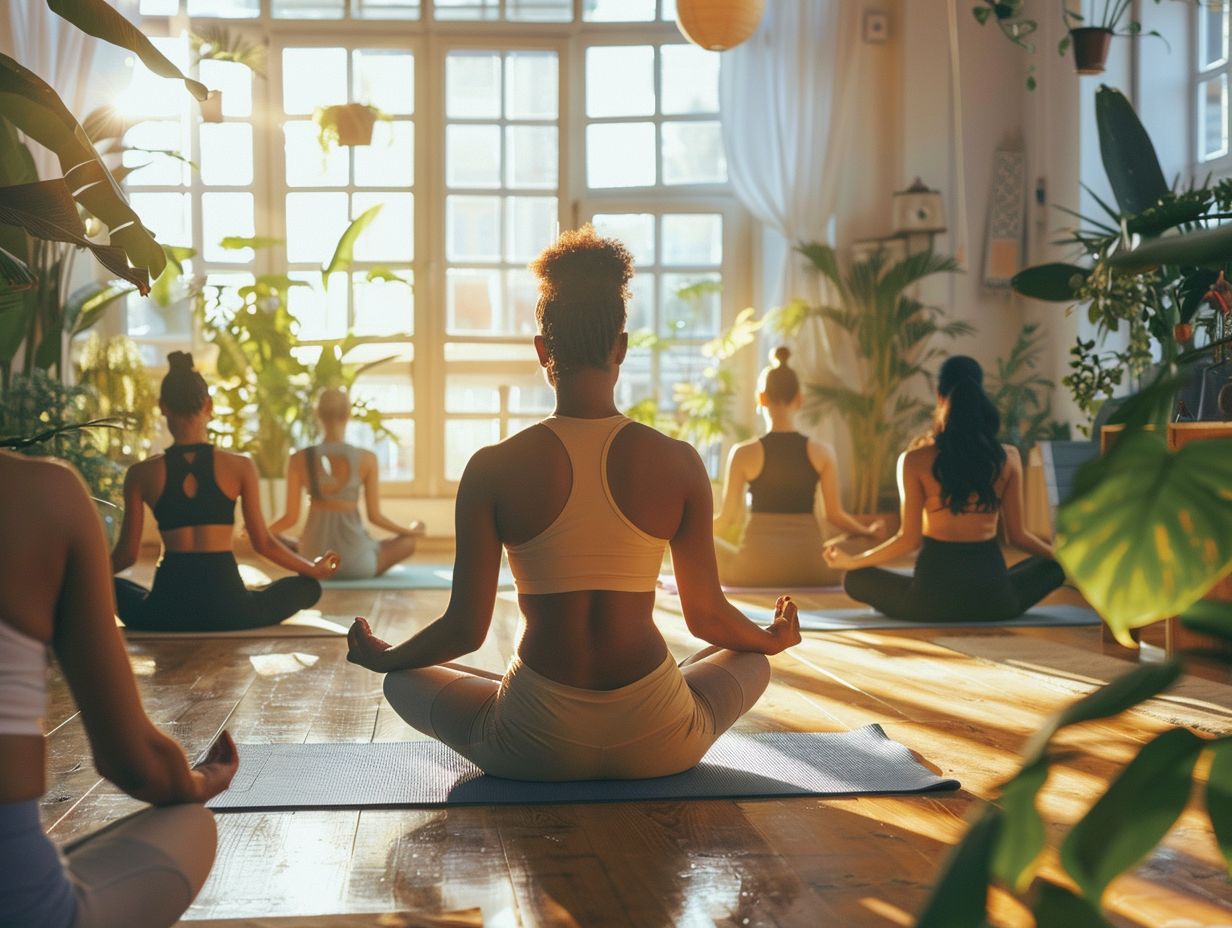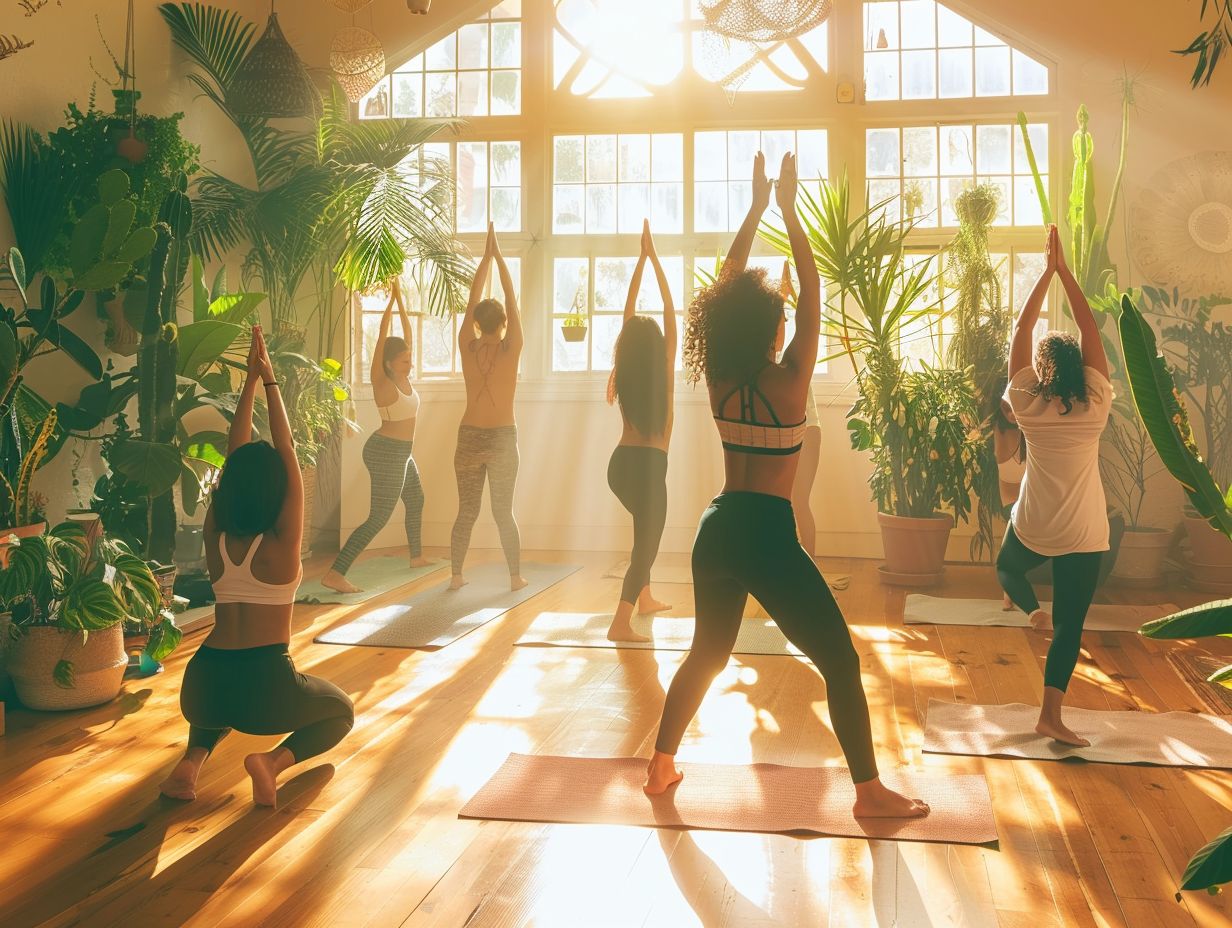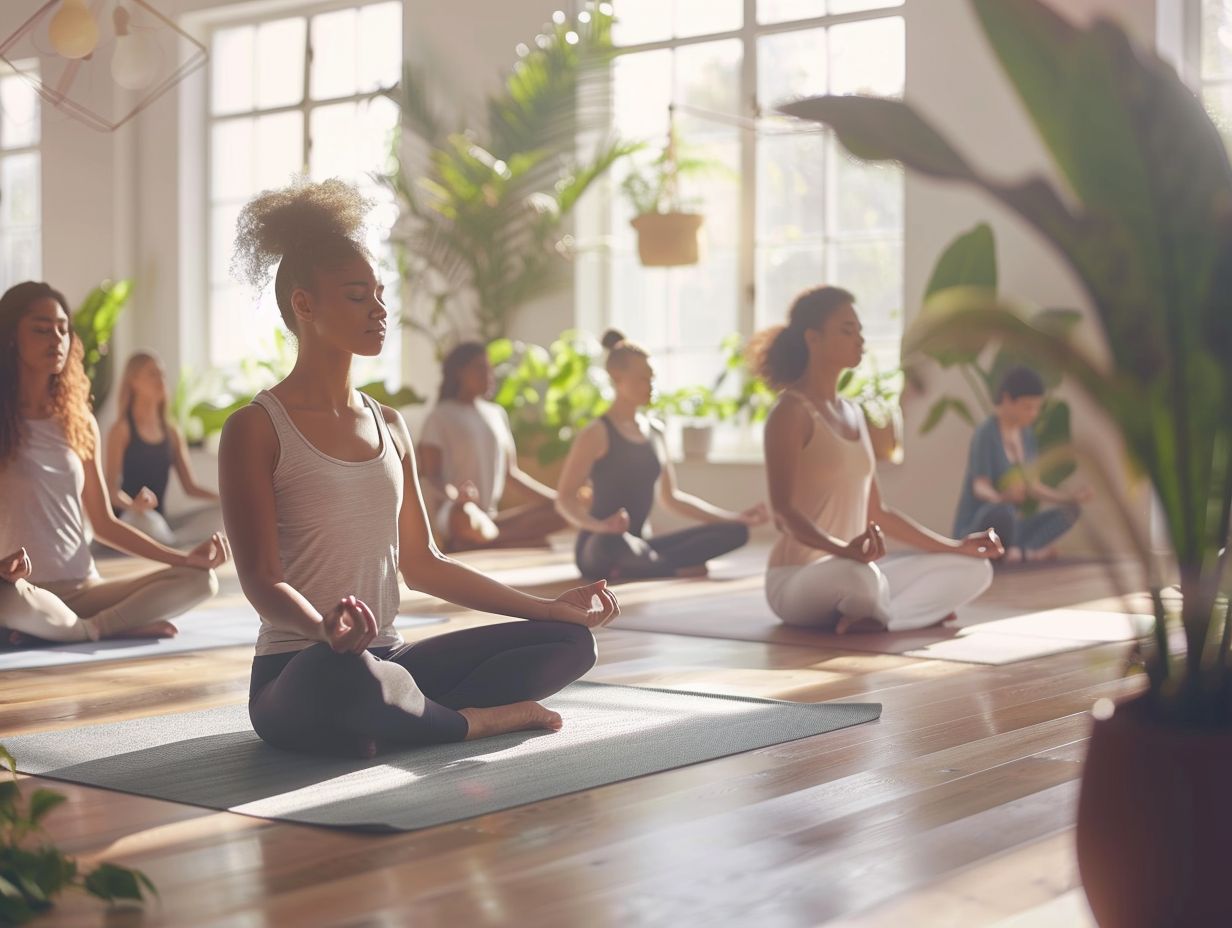The Role of Asanas and Pranayama in Yoga
Yoga transcends mere physical practice; it embodies a holistic approach to achieving harmony between the mind and body.
At the core of this transformative journey lie asanas and pranayama, two essential components that significantly enhance overall well-being. Asanas, or poses, are instrumental in fostering strength and flexibility, while pranayama, the art of breath control, cultivates mental clarity and relaxation.
This guide delves into the essence of yoga, exploring the diverse types and benefits of asanas and pranayama, as well as their synergistic effects on enriching daily practice. Whether one is a beginner or seeking to deepen their understanding, this resource provides valuable insights to seamlessly integrate these fundamental elements into their routine.
The Meaning of Yoga

Yoga represents a holistic practice that goes far beyond mere physical exercise; it embodies a profound philosophy dedicated to promoting wellness through the harmonious integration of body, mind, and spirit.
The essence of yoga encompasses multiple dimensions, including physical postures (asanas), breathing techniques (pranayama), and meditation, all thoughtfully designed to enhance physical health, emotional well-being, and spiritual growth.
This ancient discipline nurtures self-awareness and inner peace, inviting individuals to cultivate mindfulness and forge a deeper connection between mind and body, all while experiencing the therapeutic benefits of relaxation and stress relief.
What are Asanas in Yoga?
Asanas, or physical postures, constitute a fundamental aspect of yoga practice, acting as a gateway to enhanced physical fitness, flexibility, and strength while simultaneously promoting body alignment and balance.
These postures are meticulously crafted to elevate the practitioner s physical abilities and to facilitate the flow of energy throughout the body, helping with the release of muscle tension and nurturing a profound sense of relaxation.
Through the engagement in diverse asanas, individuals can delve into and enrich their understanding of their physical forms, ultimately contributing to their overall wellness and holistic health.
What are the Different Types of Asanas?
The diverse world of asanas encompasses a variety of styles and categories, including Hatha Yoga, Vinyasa, Kundalini, and restorative practices, each presenting distinct approaches to physical postures and movement.
Hatha Yoga, for example, provides an excellent foundation for beginners, introducing essential poses and alignment techniques that lay the groundwork for further exploration. In contrast, Vinyasa captures the attention of those who prefer a more dynamic and rhythmic practice, emphasizing fluid transitions between poses.
Kundalini, on the other hand, caters to individuals seeking spiritual growth and mental clarity. This style intricately weaves rigorous physical activity with breathwork and chants, creating a profound experience for its practitioners.
Meanwhile, restorative practices offer a gentle escape for individuals at all levels, serving as a sanctuary for stress relief and healing an ideal choice for recovery and rejuvenation.
By diving into these various styles, individuals can discover the most harmonious approach that resonates with their unique lifestyles, aspirations, and physical capabilities.
What are the Benefits of Practicing Asanas?
Practicing asanas provides a wealth of benefits that extend far beyond mere physical fitness, significantly enhancing overall health and well-being. By improving flexibility, strength, and balance, these postures also deliver substantial mental and emotional support.
Regular engagement in yoga asanas can be pivotal in alleviating stress, fostering mental clarity, and cultivating a profound sense of relaxation that transcends the practice itself. The therapeutic advantages of asanas are widely acknowledged, helping withdividuals in achieving injury prevention, maintaining emotional equilibrium, and experiencing greater vitality in their daily lives.
Integrating asanas into a daily routine has been associated with lower levels of anxiety and depression, underscoring their efficacy as a valuable complement to conventional mental health strategies. Practitioners frequently report an invigorating surge of energy following their sessions, which can elevate productivity and enhance overall mood.
Research indicates that these techniques not only refine physical attributes but also build resilience against life s inevitable challenges, give the power toing individuals to manage stress with greater efficacy.
Testimonials often emphasize the transformative impact of consistent practice, highlighting benefits that extend beyond the physical realm to include improved concentration and emotional stability.
What is Pranayama in Yoga?
Pranayama, the ancient art of breath control, holds a pivotal position within the holistic discipline of yoga, fostering a deeper connection between the body and mind through deliberate breathing techniques.
This practice not only enhances energy flow and relaxation but also complements mindfulness and meditation, enabling individuals to enrich their personal yoga journey.
By mastering pranayama, practitioners cultivate a heightened awareness of their breathing patterns, which nurtures a profound sense of calm and balance, significantly enhancing their emotional and physical well-being.
What are the Different Types of Pranayama?

A variety of pranayama techniques exist, each meticulously crafted to manipulate breath in distinct ways, yielding unique benefits for practitioners. Among the most recognized techniques are Ujjayi, Nadi Shodhana, and Kapalabhati, each highlighting specific breathing patterns and objectives.
Ujjayi involves a gentle constriction of the throat, emanating a soothing ocean-like sound that fosters breath awareness and relaxation. In contrast, Nadi Shodhana, also known as alternate nostril breathing, is focused on harmonizing the body’s energy centers. Kapalabhati employs rapid inhalations and exhalations to invigorate and clarify the mind, showcasing the diverse therapeutic advantages inherent in pranayama practices.
Practitioners may also delve into other methods, such as Bhramari, which produces a resonant humming sound during exhalation, effectively alleviating anxiety and enhancing concentration. Additionally, Sheetali offers a cooling inhalation technique that calms the mind while detoxifying the body.
Each of these breathing exercises not only encourages relaxation but also aligns both physical and subtle energies, nurturing a profound connection between mind and body.
By integrating these pranayama techniques into their daily routines, individuals can anticipate remarkable enhancements in overall well-being and mental clarity.
What are the Benefits of Practicing Pranayama?
Practicing pranayama offers a multitude of health benefits that extend beyond mere breath control, profoundly influencing emotional balance and mental clarity. Through regular engagement in pranayama, individuals can adeptly manage stress, cultivate a relaxation response, and enhance their overall sense of well-being.
This practice give the power tos them to embrace mindfulness, fostering a deeper awareness of their breath and its significant effects on their mental and emotional health, ultimately leading to improved energy balance and resilience in the face of life’s challenges.
The rhythmic essence of pranayama serves to regulate the nervous system, effectively reducing anxiety and promoting a state of calm. As individuals delve deeper into various techniques, they often experience heightened focus and concentration, allowing them to navigate daily tasks with greater ease and efficiency.
Moreover, the benefits of pranayama transcend fleeting moments of tranquility, fostering lasting changes in one s relationship with stressors. By thoughtfully integrating this ancient practice into their daily routines, individuals access a wellspring of strength and emotional stability, enhancing not only their health but also enriching their relationships and overall quality of life.
How Do Asanas and Pranayama Work Together in Yoga?
The interplay between asanas and pranayama within yoga practice offers a holistic framework for enhancing both physical and mental well-being. These two elements collaborate seamlessly to foster optimal energy flow and mindfulness.
Asanas serve to prepare the body for pranayama, opening vital physical channels and ensuring proper alignment. In turn, pranayama amplifies the benefits of asanas through focused breath control and heightened awareness. This harmonious relationship nurtures a profound mind-body connection, enabling practitioners to fully embrace the transformative potential of yoga.
How Do Asanas Prepare the Body for Pranayama?
Asanas play a crucial role in preparing the body for pranayama by facilitating proper alignment, enhancing flexibility, and promoting a relaxation response that paves the way for effective breath control. Engaging in these physical postures allows practitioners to release tension and cultivate body awareness two essential elements for optimizing energy flow during pranayama practices. This preparatory phase not only enhances physical readiness but also fosters a mindful approach to breathwork, thereby deepening the overall yoga experience.
Incorporating a diverse array of asanas targets various muscle groups, leading to a more comprehensive increase in flexibility and improved blood circulation. When the body is well-aligned, the risk of strain diminishes, allowing for smoother transitions into breathwork. As individuals advance through their practice, a mindful awareness of their bodies encourages them to tune into subtle sensations, facilitating a more profound connection with each inhale and exhale.
This holistic approach ensures that energy flows freely, enhancing the effectiveness of pranayama and promoting a sense of inner calm and connection.
How Do Pranayama Techniques Enhance the Effects of Asanas?
Pranayama techniques profoundly enhance the effectiveness of asanas by introducing focused breath control, which fosters deeper muscle relaxation and heightened awareness within the practice. By consciously integrating breathwork during asana sessions, practitioners can facilitate improved energy flow and concentration, cultivating a more profound connection to the body.
This harmonious combination not only amplifies the therapeutic benefits of both practices but also encourages a meditative state that nurtures inner peace and self-discovery along the yoga journey.
Employing pranayama methods, such as Ujjayi or Nadi Shodhana, guides practitioners toward a serene mental state, allowing for the maintenance of postures over extended durations. As the breath serves as an anchor during challenging poses, it alleviates the struggle by enhancing focus, ultimately leading to a more fulfilling experience.
The rhythmic breathing patterns established through pranayama aid in alleviating stress and anxiety, promoting emotional stability. When paired with asanas, these techniques cultivate physical strength while elevating an individual s overall sense of well-being, creating a harmonious balance between body, mind, and spirit.
What is the Role of Asanas and Pranayama in a Yoga Practice?

Asanas and pranayama stand as foundational pillars in a comprehensive yoga practice, each playing a distinct role in fostering mind-body balance and promoting overall health and well-being.
Through the seamless integration of physical postures and breathing techniques, practitioners cultivate flexibility, strength, and relaxation while simultaneously addressing emotional well-being and personal growth.
This harmonious interplay between asanas and pranayama not only enhances the physical dimensions of yoga but also enriches the mindfulness and self-awareness vital for spiritual growth and holistic healing.
How Do Asanas and Pranayama Help in Achieving Mind-Body Balance?
The harmonious interplay of asanas and pranayama is essential for achieving a profound mind-body balance, as each component enhances the other, nurturing both emotional well-being and physical health. Asanas serve to ground the body and release accumulated tension, thereby setting the stage for pranayama to deepen breath awareness and facilitate relaxation. This integration fosters self-awareness, encouraging a richer understanding of one s physical and emotional states, ultimately leading to a more balanced and fulfilling yoga practice.
The implementation of these techniques has been shown to effectively reduce anxiety, elevate mood, and enhance overall mental clarity. As practitioners flow through various postures, they engage their muscles while simultaneously calming their minds, cultivating a state of presence and mindfulness. This synergy alleviates stress and bolsters emotional resilience, give the power toing individuals to navigate life’s challenges with greater ease.
By establishing a routine that incorporates breathing exercises alongside physical movements, one can tap into their inner resources, fostering a sense of wholeness and vitality that enhances both daily existence and personal growth.
How Do Asanas and Pranayama Contribute to Overall Health and Well-Being?
The combined practice of asanas and pranayama presents substantial health benefits that significantly enhance overall well-being, offering a comprehensive approach to both physical fitness and emotional balance. Asanas cultivate strength, flexibility, and proper body alignment, while pranayama introduces effective breathing techniques that promote relaxation and relieve stress. Together, these practices form a wellness routine that nourishes both the body and mind, give the power toing individuals to develop resilience and lead a healthier, more balanced life.
Integrating these practices into daily routines can markedly alleviate tension, resulting in improved mental clarity and emotional stability. The incorporation of asanas encourages better circulation and muscle tone, while the rhythmic, mindful breathing of pranayama serves as a natural remedy for anxiety. This synergy not only revitalizes the practitioner physically but also equips them with essential coping mechanisms to navigate life s challenges.
Ultimately, the harmony achieved through asanas and pranayama fosters a holistic environment for personal growth, ensuring that practitioners remain grounded and centered amidst the chaos of everyday life.
How to Incorporate Asanas and Pranayama in Your Daily Routine?
Incorporating asanas and pranayama into one s daily routine can profoundly elevate overall wellness, offering essential tools for effective stress management, injury prevention, and mindfulness practices.
Establishing a personalized practice that harmoniously blends physical postures with breathing techniques not only nurtures the body but also fosters emotional equilibrium and mental clarity.
By committing time to these practices, individuals can seamlessly integrate the myriad benefits of yoga into their everyday lives, cultivating a healthier lifestyle and a deeper sense of self-awareness.
What is the Recommended Duration for Practicing Asanas and Pranayama?
The recommended duration for practicing asanas and pranayama can vary significantly, influenced by personal goals, experience level, and available time. However, consistency emerges as a fundamental principle for fully experiencing the benefits of these practices.
Beginners are encouraged to initiate their journey with a modest commitment of 10 to 15 minutes daily, gradually progressing to 30 to 60 minutes as they grow more at ease with the diverse postures and breathing techniques. Establishing a regular practice not only enhances physical health but also cultivates a profound sense of self-connection and promotes emotional well-being.
As individuals advance in their practice, both the duration and complexity may evolve, often mirroring their aspirations for increased flexibility, strength, or mindfulness. Those with specific objectives, such as enhancing athletic performance or deepening mindfulness, may choose to dedicate additional time to particular routines that resonate with their intentions.
This adaptability in practice lengths and styles plays a crucial role in fostering sustainable daily habits. Thus, with thoughtful adjustments, practitioners can curate a personal yoga journey that remains both enriching and manageable, avoiding any sense of being overwhelmed.
What are Some Tips for Beginners to Start Practicing Asanas and Pranayama?

For those embarking on the journey of practicing asanas and pranayama, there are several key insights that can facilitate a smooth transition into this enriching realm of holistic health and wellness. It is imperative to establish a comfortable space and gather essential yoga props, such as mats and blocks, to provide necessary support during practice.
Enrolling in yoga classes offers invaluable guidance and inspiration, while a mindful approach enhances body awareness and mitigates the risk of injury.
Creating a calming environment is essential, as it sets the stage for focused sessions and fosters deeper concentration. Beginners are encouraged to start with simple, foundational poses that prioritize proper alignment and breath awareness. Engaging with curated instructional videos can further aid in grasping various techniques and modifications tailored to individual experience levels.
It is vital to remember that each person s journey is distinct; fostering self-compassion and patience will significantly enrich their connection to yoga, transforming it into a more fulfilling practice over time.
Frequently Asked Questions
What is the role of asanas in yoga?
Asanas, or yoga poses, play a crucial role in yoga practice. They help to strengthen and stretch the body, improve flexibility, and cultivate mindfulness and focus.
How does pranayama complement asanas in yoga?
Pranayama, or breath control, complements asanas by regulating the flow of prana (life force energy) in the body. This helps to deepen the benefits of the poses and create a more meditative state.
Can anyone practice asanas and pranayama in yoga?
Yes, asanas and pranayama can be practiced by people of all ages and fitness levels. However, it is important to listen to your body and modify poses as needed to avoid injury.
What are some common asanas used in yoga practice?
Some common asanas include downward-facing dog, warrior poses, tree pose, and child’s pose. These poses can be adapted for beginners or advanced practitioners.
How can asanas and pranayama benefit overall health and well-being?
Asanas and pranayama have numerous benefits for the body, mind, and spirit. They can improve physical strength and flexibility, reduce stress and anxiety, and promote inner peace and balance.
Is it necessary to practice both asanas and pranayama in yoga?
While both asanas and pranayama are important components of yoga, the specific practice may vary depending on the style or tradition. However, incorporating both can help to create a well-rounded and holistic practice.
